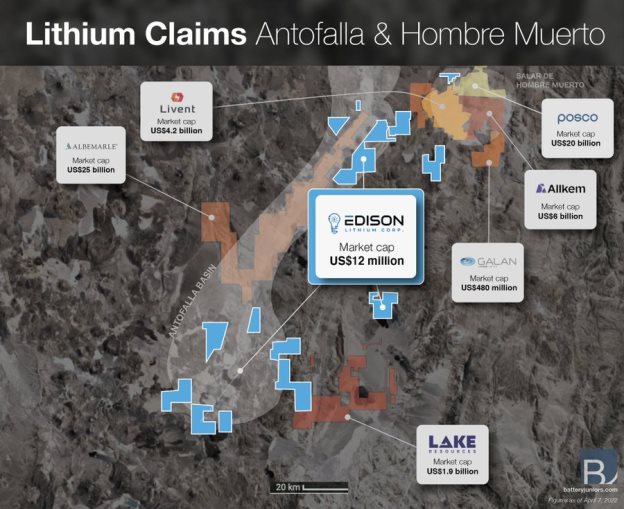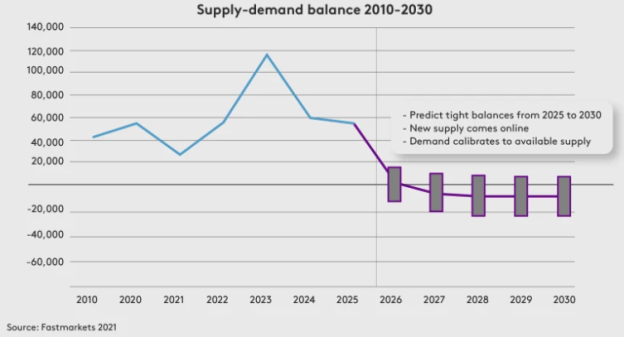Lithium Demand,
Prices Skyrocketing: New Sources Needed
April 19, 2022 -- InvestorsHub
NewsWire -- via ROBIN
LEFFERTS -- Demand for
lithium is increasing rapidly due to the proliferation of electric
batteries dependent on the mineral. McKinsey
forecasts the battery cell
market will grow at a minimum of 20% per year through 2030, which
would put the global value at $360 billion. Depending on market
conditions and the possible positive impacts of economies of scale,
the firm believes the global electric battery market could
plausibly reach $410 billion by that time.
Along with rising demand and in
conjunction with a relatively capped supply, lithium prices have of
course skyrocketed. According to Benchmark Mineral Intelligence,
the price of raw lithium rose 344.9% between January 2021 and
January 2022.

Source:
Benchmark Mineral Intelligence
Companies around the world are
scrambling to secure existing supply and create new sources for
lithium. Australia, Chile, and China are currently the largest
producers of lithium, with Australia greatly expanding production
over the last four years or so. Argentina currently rates fourth in
lithium production, increasing output by 60% in 2016 alone. The
country, known for its favorable regulatory environment, may be
poised for an even bigger leap over the next several years as
claims increase to meet demand while neighboring Chile
simultaneously debates its
approach to mining.
One prospective lithium miner
positioned to help drive increased production in Argentina
is Edison
Lithium Corp. (TSX-V: EDDY) (OTCQB:
EDDYF) (FSE: VVO). Edison holds a total of over 148,000 hectares
(~366,000 acres) of lithium claims in two prime areas of the
country.
Lithium
in Chile and Argentina
Chile produces about 25% of the
world's lithium supply and sits on almost half of the
world's proven reserves. The country has historically
been committed to mining at almost any cost, but a recent election
of a new government there, combined with issues
raised by indigenous populations regarding mining practices on or near their
lands, has created an air of uncertainty in the country. In fact,
the country is in the midst of rewriting
its constitution and some
of the central issues surround the influence of the
country's powerful mining industry. Though mining in
resource-rich Chile will undoubtedly remain, the regulatory
landscape around the industry is in question.
Argentina's lithium zones lie just on the other side of
the border with Chile, and its reserves haven't been proven or its resources exploited nearly
to the extent of its neighbors to the west. But the potential is
clearly there.
One of Edison
Lithium's areas of focus is the Salar de Antofalla, in
the highlands near the border of Argentina and Chile. Edison
acquired claims here as part of their purchase of Resource Ventures
S.A. Several other companies have claims in the area as
well.

In 2016 Albemarle,
the world's second largest lithium producing company,
acquired claims in the Antofalla region from Bolland Minera S.A.
Bolland's drill program had identified a substantial
resource of both lithium and potassium (potash) to over 500 meters
depth, suggesting that Antofalla is one of the deepest basins in
the region. At the time, Albemarle believed its resource would
prove to be Argentina's largest lithium resource. The company has not
announced further development of the property as it tends to more
advanced operations in other regions.
Edison Lithium's claims in the Antofalla basically surround
Albemarle's, and previous transient electromagnetic (TEM)
geophysical studies of some of Edison's claims indicate potential brine resources
down to a similar depth of 500 meters. To date, there has not been
a NI 43-101 technical report conducted on the claims to prove the
resource. Edison's Antofalla claims total about 107,000
hectares, or about 264,000 acres.
The company has completed
an Environmental Impact Assessment for the prospecting phase of exploration of its
Antofalla claims. The submission is basically a plan of work for
the next phase of development as Edison moves toward confirming the
lithium resources on its claims.
New Sources
Needed
According to Fastmarkets, new
projects coming online will be able to meet demand through 2025,
but the next five years there could be a deficit as demand
continues to skyrocket while new production levels struggle to keep
up. The research firm points to Australia and the Lithium Triangle
(Argentina, Chile, and Bolivia) as the most likely areas for new
production. That's where a company like Edison Lithium comes
into the picture.

Source:
Fastmarkets
Such
forecasts always lead to deals and consolidation as investors look
to capitalize. In 2021, large mining companies
closed over $9 billion worth of M&A
deals for Latin American assets, and almost half of those targeted
lithium. Three of the top six deals on the linked list were for
Argentinian lithium assets.
Edison
Lithium (TSX-V: EDDY) (OTCQB: EDDYF) (FSE: VVO) is positioned at
the nexus of several enticing trends. Lithium demand is through the
roof with no signs of slowing down. Companies are racing to bring
new production online to take advantage of the favorable market
conditions. The Lithium Triangle is one of the
world's
prime locations for lithium production. Edison's
claims need to be proven but have shown great potential for deep
reserves, surrounding claims held by the second largest lithium
supplier in the world that are thought to represent
Argentina's
largest lithium resource.
Keep an
eye out on the lithium market in general, and Edison Lithium Corp.
in particular. Its ~$13 million market capitalization belies the
tremendous potential of its holdings.
SOURCE: ROBIN
LEFFERTS